|
|
Post by chadwilliam on Jun 25, 2024 15:21:18 GMT -5
Whoops! Thanks for the correction!
|
|
|
|
Post by chadwilliam on Jun 27, 2024 11:29:41 GMT -5
New York World's Fair Comics 1940 Issue (July 1940) "The Sandman Goes to The World's Fair"
Author: Gardner Fox Artist: Chad Grothkopf "The Sandman - Friend of the just and enemy of the oppressors is in reality Wesley Dodds, wealthy young athlete ... who has turned to fighting crime and criminals for the thrill of adventure and a desire to aid those too weak to aid themselves........!!!!"
 Synopsis Synopsis: We join The Sandman during the final moments of an adventure already in progress. Beating up a pair of kidnappers and then calling in the details to the police, the scene cuts to home of D.A. Belmont upon whom Wesley Dodds pays a visit though it is his daughter, Dian he is hoping to find. Learning that she's attending The World's Fair with her Aunt in New York, a relieved Dodds remarks, "That sort of lets me out - I'm so busy I won't be able to join them!" Unfortunately for Dodds however... A group of gangsters have read of Dian Belmont's intention to visit the Fair and take advantage of the situation to gain some payback against the D.A. responsible for at least of their numbers - 'Slugger' Slade - going up the river in the past. Inconveniently though, the hoodlums are spotted by a G-Man walking the grounds and quickly booted out. However, when Dian decides to return to her hotel following a brief walkaround at the exposition, she finds herself and her Aunt Agatha waylaid by Slugger's men. Forced into the ruffian's car, the men depart with a threat to Aunt Agatha to "keep your trap shut, Auntie! Say nothin' to the police, or it's your niece's life!!" And with that, Belmont is taken to the gangster's estate. It isn't long before D.A. Belmont hears the news. "What's that, Aunt Agatha!? Dian - kidnapped! - Follow their instructions!! Don't call the police!"

Imploring Dodds for his assistance, the playboy agrees and arrives at La Guardia where he encounters Aunt Agatha. Providing Dian's boyfriend with a selection of candid photos she discretely snapped of her attackers, the playboy recognizes them as 'Slugger's' thugs. Although Dodds is unable to gain an invite into Slugger's estate when he shows up at his door, The Sandman has no such difficulty, gassing the mobster's rather uncouth and smarmy butler to acquire entry.      Locating a secret panel upon the estate, The Sandman investigates and finds Dian in a hidden chamber.  Fighting off Slugger and his goons, the pair make their way through the house stopping only long enough for our hero to find among the villain's effects certain documents incriminating him and his gang of their crimes. Phoning in the details to the proper authorities, the couple take their leave. The following day, Wesley meets with Dian and Agatha - with the latter greeting Dodds with the admonishment "Why can't you be more like The Sandman? Thanks to him, Dian is safe!!" - and arrange to catch up with the old lady at the Fair. Noticing a large crowd gathering around the parachute jump when they arrive, Dodds and Dian are taken by surprise when they learn the identity of the old woman who has ridden the attraction fifty-two times: "Yipee!! It's Aunt Agatha!"
And there's that stupid jig Dodds giddily danced last issue again. The two decide to leave Agatha alone as they go off by themselves. The episode ends with Dodds proclaiming that The World's Fair is "as much fun as being The Sandman!" 
Thoughts: "It is probably stating the obvious that this must have been when it became clear to the publishers sales went to the heroes in colorful, skin-tight costumes like Superman," observed MWGallaher recently. While The Sandman hasn't yet donned his purple and yellow jumpsuit, things have certainly gotten a lot more colorful and flamboyant for our hero. I didn't remark upon it at the time, but following a brief period where The Sandman's suit was colored brown, it switched over to a colorful green with Adventure Comics #44. Not a drastic change, but perhaps the first concession made in this strip to the allow some splashiness into the feature. But it isn't really anything tremendously visual about the series which gotten more colorful but the feel of the adventures themselves. Previously, a rather silent figure who lets the residual scent of violets left from his gas gun do his talking for him, The Sandman has since become boldly chatty with his opponents, providing such proclamations as "You've done your last kidnapping, 'Blackie' Saunders!" before slugging the guy in the face and "You yellow rat!" as he turns his attention towards his pal. He's hardly a laughing, young daredevil, but he certainly does seem to enjoy making an exciting entrance than this time last year. Comparing the enjoyment of visiting The World's Fair to the "fun [of] being The Sandman" also signifies a certain immaturity on the part of a once somber mystery man. Last year's World's Fair comic is notable as the issue in which The Sandman made his debut. I suspect that National had The Sandman story ready to go and reworked it just slightly enough to fit in with the World's Fair theme that it's inclusion made sense there. This time around, it feels as if things have been rushed. Despite Chad Grothkopf taking over art duties for this adventure, much of the artwork from Creig Flessel's previous entry (found in Adventure Comics #49) has been reworked here. That image of Dodds dancing his jig; another where he addresses the reader at the close of the last story is reused when he talks with The D.A. in this one; The Sandman's closing fight scene last time being repurposed here are all borrowed from Flessel (who contributes the opening splash panel which will be used again in Adventure Comics #50). Grothkopf even copies from himself on at least one occasion in the same story when his Sandman figure is just a redrawn figure of the G-Man who kicked Slugger out of the park at the start of this tale. Swipes happen, but I sure did notice them a lot in this story. I guess when you're putting together a giant-sized comic timed to coincide with The World's Fair, your regular Sandman artist might need someone to step in and Grothkopf was selected and handed a sample of the most recent story available as a guide. Interestingly, Grothkopf will make a significant contribution to The Sandman mythos at a later date when he and Paul Norris introduces Sandy, The Golden Boy in Adventure Comics #69. Actually, I'm not so sure that "The Sandman Goes to The World's Fair" does follow on the heels of Adventure #49. While I'm following the order of the stories as they're presented in The Sandman Archives, The GCD states that it would have been released on July 3, 1940. If that's the case, then this story should follow Adventure Comics #52 but there's a catch the way I see it... D.A. Belmont learns The Sandman's identity in Adventure Comics #48 when Wesley and Dian take him into their confidence aboard his yacht. In a glaring omission I can't believe I made, I didn't actually point this fact out during the course of my review for that tale. No idea how I slipped up but, well, here you go, I'm mentioning it now. But you know who else overlooked this detail? Gardner Fox since in the very next issue of Adventure Comics has Belmont offer a public challenge to The Sandman that he reveal his identity to the world - something he wouldn't do if he knew he was dating his daughter. However, since he knows his identity in this adventure, I think it makes sense to follow the narrative we've been presented with while it remains fairly coherent. Now what about the story itself? Well, there's a reason I qualified my last statement with the term "fairly coherent". Though it's nice to see D.A. Belmont again, that irascibility which permeated the character before has vanished here. He's frazzled, petrified, and literally spraying sweat when he learns of his daughter's kidnapping. He doesn't even look like the same guy. Here he's younger, jowelier, moustache free, and just wracked with nerves. Compare his reaction here to how he responded in Adventure #48 when pushed off his yacht and rescued by The Sandman - "Get a boat, you young idiot!" Even when being saved he's got his hackles up. Perhaps not a huge deal since it's his daughter who we're supposed to focus on, but I did like the orneriness of the character in his first two appearances. Still, it's a very one-dimensional depiction of a formerly two-dimensional character. I can't say I'm not disappointed. I wonder how close Aunt Agatha is to Dian Belmont. After all, it wasn't very long ago that the world thought that Dian had died as a baby and yet they seem to have settled in nicely together - nicely enough that a possessive Agatha pulls the whole "Why can't you be more like The Sandman, Wesley?" card on our hero. Again, another indication that far from being a hunted outlaw in "two continents" The Sandman is acquiring a rather wholesome reputation. I remarked in my review of the first Sandman story in which our hero visits The World's Fair that a reader could be forgiven for coming away from the story with the impression that a visit to the exposition could be something of a seedy affair what with all the crime and phony G-Men there. I wonder if someone took notice and requested that no actual crimes be depicted on Fair property this time around since it's rather unusual seeing that G-Man so handily deal with Slugger when he literally kicks him and his men off the grounds. Once they're off that property, that's it - they stay off. Not so effectively handled is Wesley Dodds who is turned away from Slugger's mansion by his rather gormless looking butler. After being refused entry, he "dash[es] about to the rear of the house" where he changes into The Sandman and then barges in on the same butler - a rather foolish strategy to employ when you have a secret identity to protect. Hey - maybe that gas gun causes amnesia - maybe that's how D.A. Belmont unlearned Dodds' secret. Alright, that's all for this one.
|
|
|
|
Post by Cei-U! on Jun 27, 2024 11:45:50 GMT -5
It's interesting that Sandman has to hop into his plane and fly to New York when previous stories have implied that he lives there. Maybe it was quicker to fly to Queens from Manhattan than to drive?
Cei-U!
I summon the short flight!
|
|
|
|
Post by chadwilliam on Jun 27, 2024 22:30:59 GMT -5
It's interesting that Sandman has to hop into his plane and fly to New York when previous stories have implied that he lives there. Maybe it was quicker to fly to Queens from Manhattan than to drive? Cei-U! I summon the short flight! Although I can't recall any specific home city being provided for The Sandman, I do know that no extensive travelling was required in New York's World Fair Comics #1 to get Dodds from his home to New York. |
|
|
|
Post by chadwilliam on Jun 30, 2024 0:11:15 GMT -5
Adventure Comics #50 (May 1940) "Tuffy and Limpy's Revenge Plot"
Author: Gardner Fox Artist: Creig Flessel "The Sandman - His accomplishments often times what police have failed to do because of legal technicalities - bring about true justice in a world harassed by crime"
Synopsis: What appears to be a case of hit and run turns into something more sinister when both the victim left laying in the road and the driver who ostensibly struck him are discovered dead - the latter murdered by gunshot and whose vehicle directed itself into a tree as our hero followed in pursuit. "Hmmm - a dead man dumped in the road - run over by a runaway car with a dead man at the wheel - very funny! - And interesting, too!"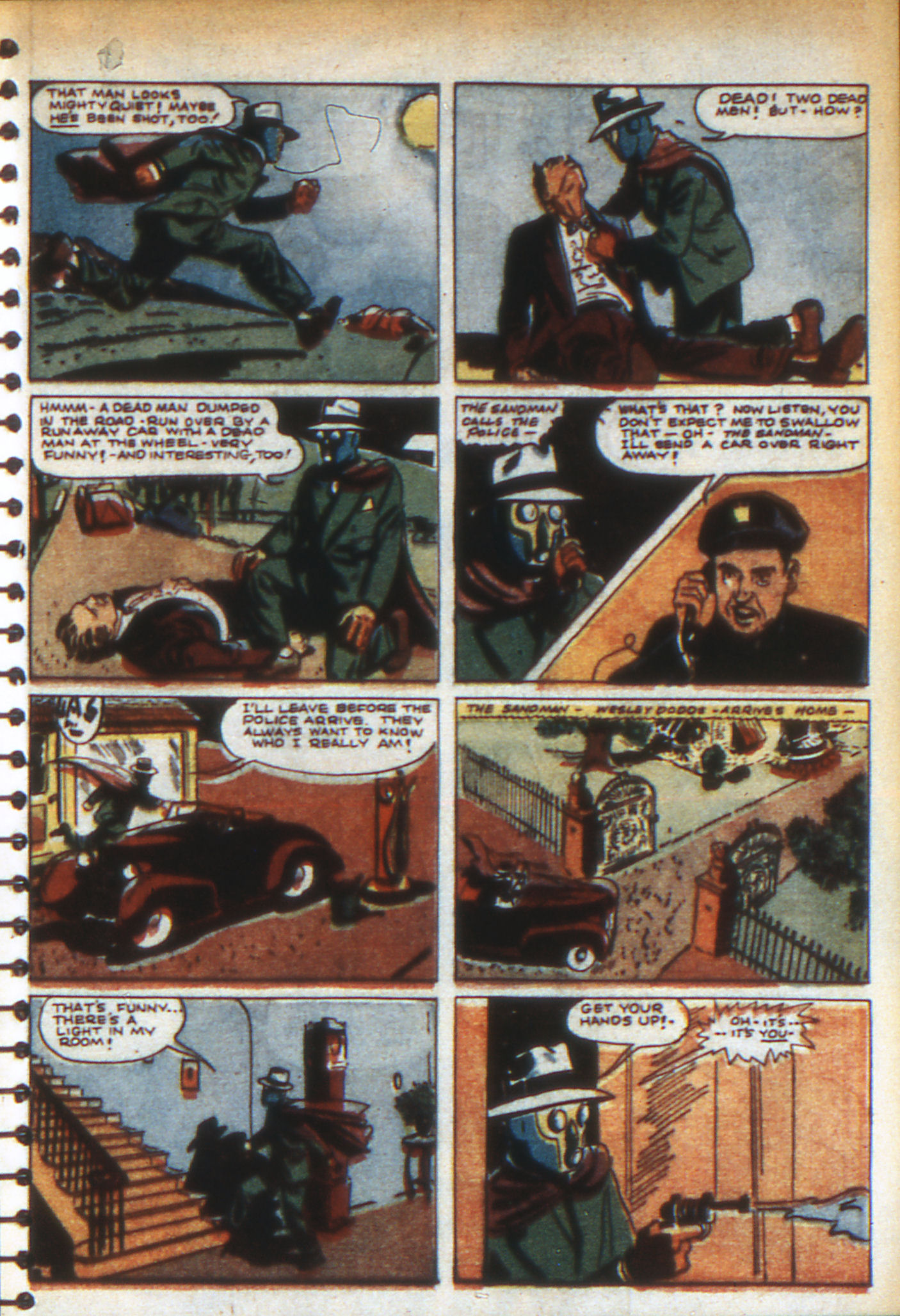 After phoning the tip into the police, The Sandman makes his way home where he is startled by an intruder. "Oh - it's – it's you-"
"You" happening to be girlfriend, Dian Belmont. Unfortunately, the crime fighter catches his mistake too late and Mrs. Belmont receives a face full of gas for her trouble. When revived, she has this to share: "Sandman, I had to see you! My father's life is in danger! Last night two men escaped from prison, men whom daddy sent up some years ago. They swore that they would kill him! ___ - To-night, over the radio, I heard that two men of the jury that sentenced them - were killed. It was made to look like a hit-and-run case! You've got to help me!"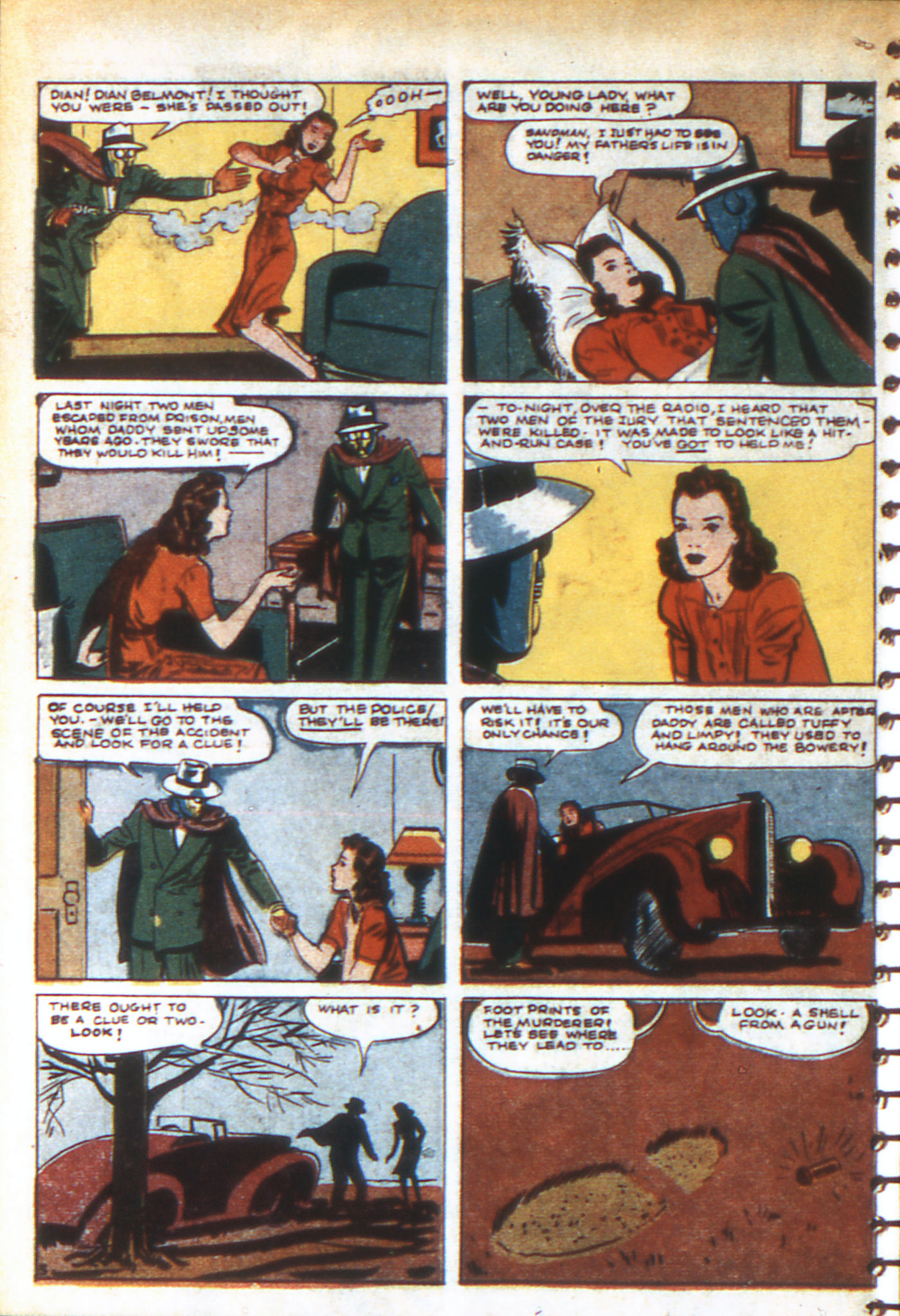 Agreeing to take the case, our mystery man revisits the scene of the crime, this time with Dian in tow. There, Dian locates a spent bullet casing while a series of footprints directs The Sandman to an empty waterfront shack. Suspecting that the owners - Tuffy and Limpy - have already headed out to murder D.A. Belmont, Dian and The Sandman race off attracting a small contingent of police officers when they do. Pulled over and threatened with arrest, our hero retorts: "I'm going after Tuffy and Limpy - they're going to kill District Attorney Belmont, to-night! Give me an escort!"
The police do just that. 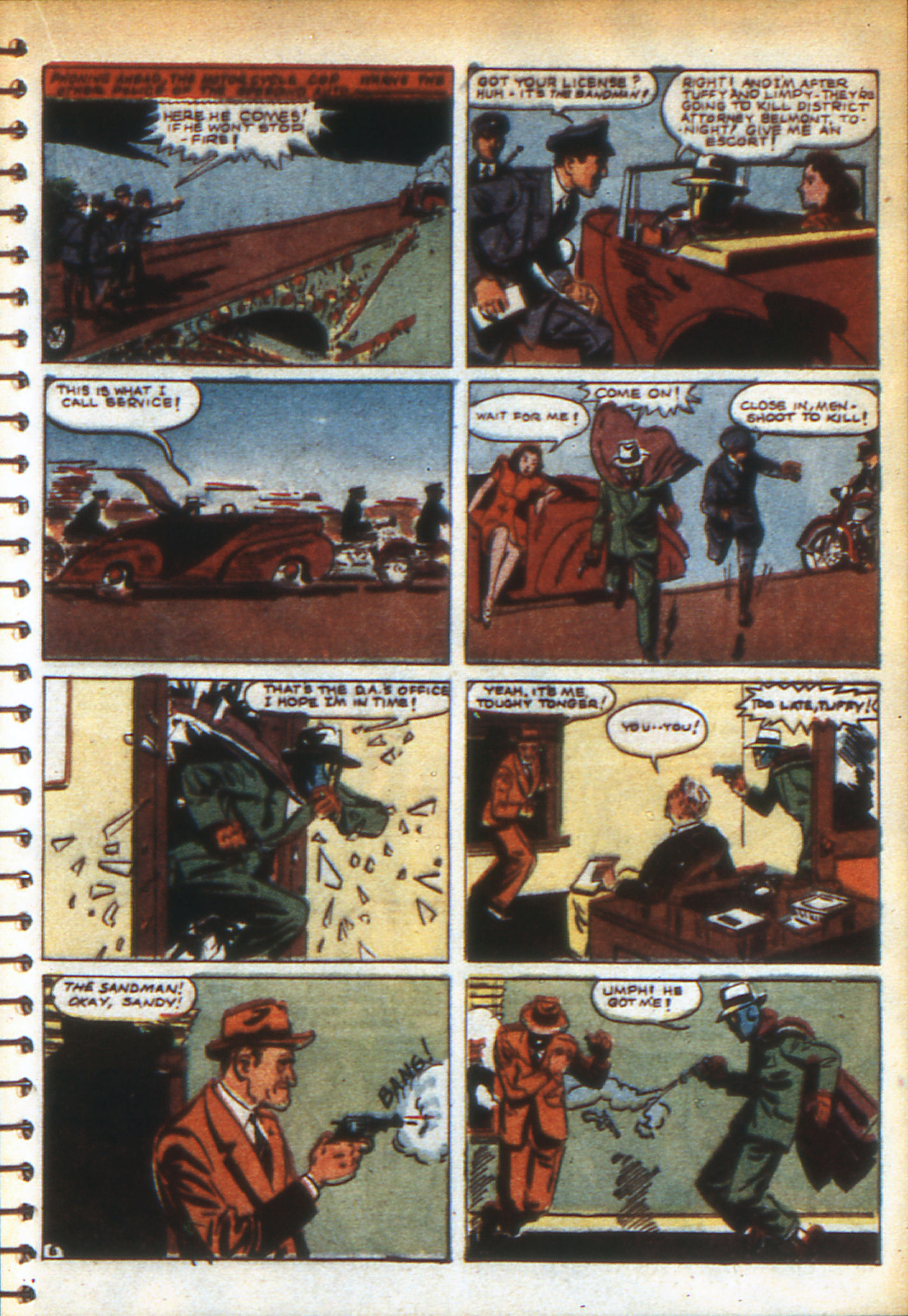 Dramatically smashing through Belmont's office window just as Tuffy (aka Toughy Tonger" prepares to put a bullet in Dian's father, The Sandman gases the would-be killer and earns himself a bullet. Tuffy is carried away by Limpy who has been waiting outside the window through which he fell while The Sandman has to contend with the elder Belmont. "You can't go now, Sandman! You're wounded!"
Countering that "no cop is ever going to look on my face while I'm alive", The Sandman leaves to give chase. Unfortunately, he succumbs to his injuries before he can close the gap and passes out. Meanwhile, Dian argues with her father. "Why did he run after them? - Because he knows you wouldn't give him police protection - even though he saved your life!"
The D.A. meekly responds that The Sandman is a known criminal and that his daughter is "excited". Advising her to return home, Dian instead checks in on our hero whose prone figure she discovers on the roof. When he awakens, the pair head off in Dian's automobile setting their course for Ching Fu's Chop House - well-known hangout of Limpy. 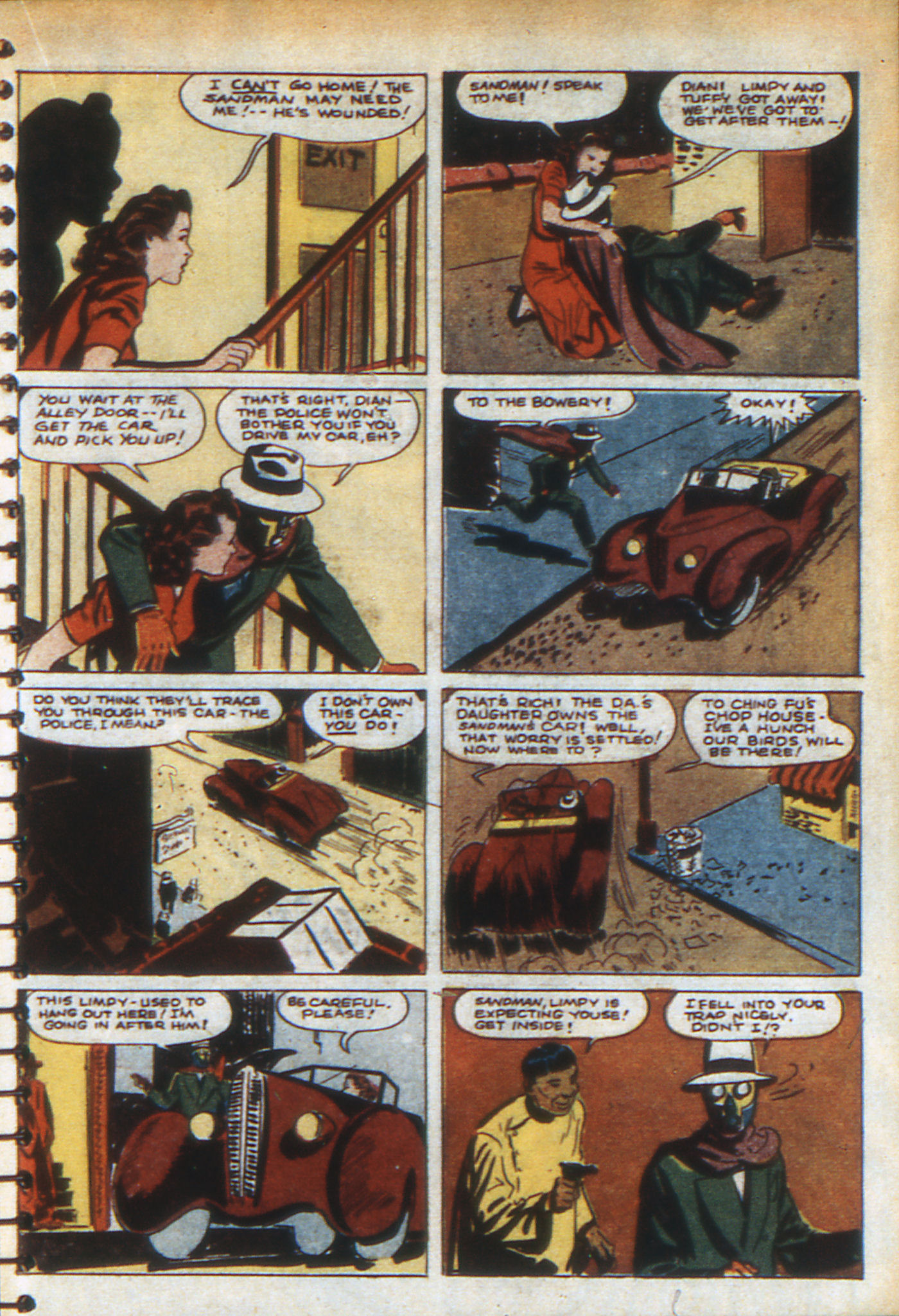 Although things don't turn out exactly as our crime buster hopes - it turns out that he's expected as the ambush he receives informs him - The Sandman manages to singlehandedly fight off the gangsters before he can be unmasked. Assisted out of the hangout by Dian - "I'm - I'm tired, Dian! Give me a chance to rest!" - The Sandman's shoulder is treated to by his girlfriend after she places a call to Police HQ. Informing Dodds of her decision to "have dad grant you a pardon for all the crimes you are supposed to have committed", we learn the result of her efforts the next day when Wesley reads of an offer from The District Attorney. "D.A. offers truce to Sandman if he will reveal his true identity"
Dodds' response? "That's a laugh! If I told the police who I am - the underworld would 'get me' that very day! No thanks, Mr. District Attorney, The Sandman remains unknown! Except to - Dian Belmont!"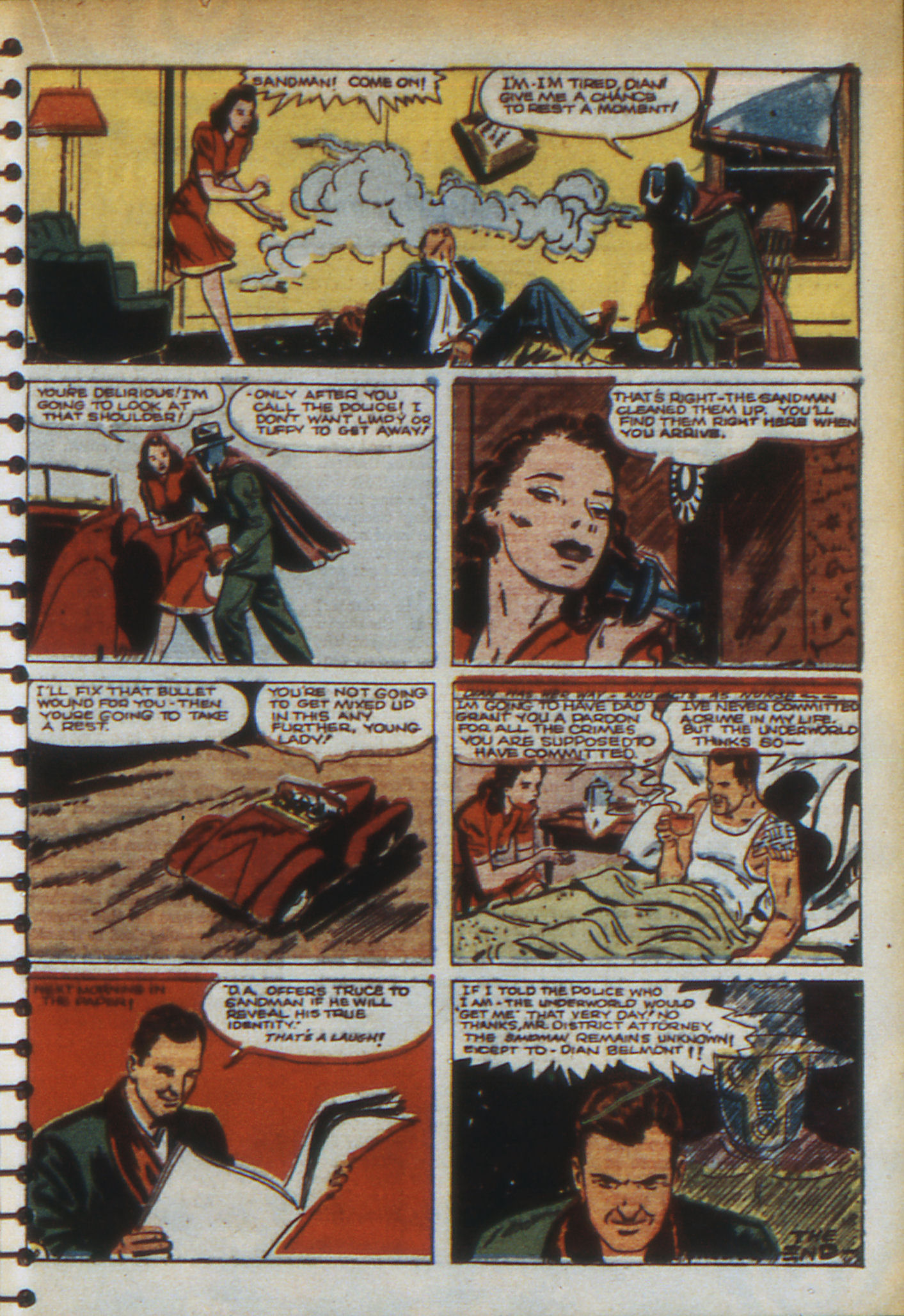 Thoughts Thoughts: After a promising start to the strip in which The Sandman matched wits against such ominous foes as The Tarantula and The Face, it seems that only underachieving henchmen are left for our hero to contend with. Tuffy and Limpy are the sort of stooges who hardly inspire confidence in their schemes. While the opening set-up is a tantalizing start to the adventure - a hit-and-run in which both driver and victim were dead to start with - things peter out quickly from there. First of all, Fox doesn't supply readers with an acceptable explanation for how a car could have been driven as far and accurately as it would have had to have been to have hit the body laying in the road. Presumably, it had been directed there by one of the killers, but if so, shouldn't The Sandman have spotted them? And why bother with such a set-up anyway seeing as how once the bullet in the driver is found, the whole hit-and-run scenario becomes moot? I do have a possible explanation for what happened, but it's an uneasy one. Though shot, that driver hadn't actually succumbed to his injuries when The Sandman encountered him on the road. It was only when our hero misread the situation and deployed his gas gun that the innocent motorist passed out, crashed into that tree, and was killed. Like I said, an uneasy explanation, but it makes more sense than what Fox presents us with. Actually, The Sandman is rather trigger happy in this one. After jumping the gun on that driver, he returns home, discovers a light on in his room, and blasts the occupant sight unseen with his gas gun - naturally, it turns out to be Dian. I can't say that he engenders much confidence in his competence thus far. From there it's another tale of The District Attorney being targeted for revenge. Unfortunately, as I noted in my previous review, D,A, Belmont has already devolved into in a rather ineffectual, timid looking, dormouse of a creature. Here he's clearly forgotten that he knows The Sandman's true identity and offers a truce he must realize that the outlaw can never accept. Though it does allow Dian to take on the role of the fearless and capable sidekick to our hero - something which I certainly appreciate - it does mean that the elder Belmont as already worn out his welcome as far as I'm concerned if this is all we're going to get from him. And, yes, once more a truce is formed between the police and The Sandman - this time for perhaps the weakest of reasons so far. I can understand The Sandman using exclusive information or evidence as a bargaining chip with the authorities, but I have no idea what he offers here to order the police around. Are half a dozen policemen so doubtful of their ability to arrest a couple of hoods like Tuffy and Limpy that they need to let The Sandman take charge? Couldn't just one of them have stayed behind to call Belmont warning him of the danger he was in? There's just too many important details in this story the reader seems expected to simply ignore or brush aside for it to satisfy. It feels designed to whet the appetite of the kid skimming through this comic at the news stand but disappoint when he's already paid for the issue and has time to read it. The Sandman takes another bullet to the shoulder - I wonder if we'll continue to see more of this now that Dian is around to conveniently extract a bullet Wesley Dodds would have trouble explaining to his doctor again and again. I will say that this story closes nicely though - as Wesley Dodds scoffs at The D.A.'s empty offer at a truce, the ghostly image of his alter ego appears over his shoulder. It's a powerful image I don't think I've seen that much elsewhere during this period - in fact, it evokes memories of Steve Ditko's work on Spider-Man - and it suggests for new readers a continuing narrative in which they'll see The Sandman at loggerheads with The D.A. in future installments. Only problem is, for those who have been reading the series for awhile, that doesn't seem very likely. 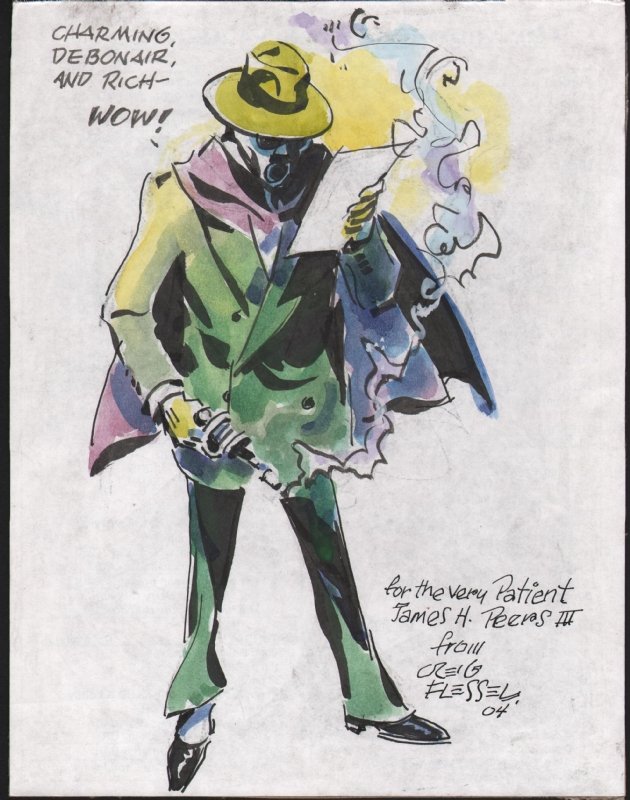
|
|
|
|
Post by MWGallaher on Jun 30, 2024 6:38:32 GMT -5
It's always a little mystifying to see a young feature like this toss away things that were just established a few issues back, like Belmont's characterization and his awareness of The Sandman's identity. You already noted that Dian has implied a surprising closeness to an aunt she didn't grow up knowing, and here she seems to have a substantial awareness of her father's past work. Yes, maybe the radio announcements provided the details about the thugs having been sent up by D.A. Belmont, but Dian also deduces that the apparent hit-and-run on the jury members was really an intentional murder, and part of the revenge plot. I don't find it convincing to think she could have dug up enough details on the trial overnight; this is written as if this was a familiar and prominent case that Dian remembers well enough to recognize the names of two jury members! So it seems that Fox is unconcerned with maintaining Dian's "origin" as a daughter newly reunited with a father she never knew.
|
|
|
|
Post by Cei-U! on Jun 30, 2024 7:37:10 GMT -5
I get the feeling that Gardner Fox, in his earliest Golden Age scripts, was hacking them out as fast as he could type them without worrying about logic or flow or the other building blocks of storytelling, and that DC editor Vin Sullivan, his former high school classmate who first brought him into the business, was letting him slide. Some sources identify Fox as a moonlighting lawyer, However, though he did pass his bar exams he never actually practiced. Rather than supplementing his income, comics were his income, which goes a long way in explaining this slipshod craftsmanship. With more experience, and under the guidance of less lenient editors, his scripting became more coherent. Incidentally, his best scripting during the Golden Age was not for DC or All-American but for Columbia, where he once more worked for Sullivan but with much better results.
Cei-U!
I summon the backstory!
|
|
|
|
Post by chadwilliam on Jun 30, 2024 18:37:43 GMT -5
I presume that Fox wouldn't have been relying solely on his memory to keep track of all the minute details of the various characters he was writing, but how thorough were his notes? Would he, for instance, have bothered to jot down a reminder of how Wesley Dodds made his fortune? That as of Adventure Comics #48, D.A. Belmont knew his identity? That Dodds has a butler named Humphries? Or were these details left to the mercy of his memory or whether he not he had flipped through a recent issue before penning the next one?
Curious as to whether he was discarding ideas because he felt they were unimportant or if they just slipped his mind - and if the latter, then that was that for ideas which could have served as the building blocks for something more.
|
|
|
|
Post by mikelmidnight on Jul 1, 2024 11:29:51 GMT -5
Wesley and Diane's relationship was one of the high points of SMT, and one of the best-depicted in comics ever, so far as I'm concerned, so when I first learned that Diane had an origin story as a former criminal, I was rather mystified by it!
I don't mind Wagner quietly leaving it to the side, but I'm halfway surprised Roy Thomas never enlisted The Lady in Evening Clothes into the All-Star Squadron.
|
|
|
|
Post by MWGallaher on Jul 1, 2024 14:45:42 GMT -5
I presume that Fox wouldn't have been relying solely on his memory to keep track of all the minute details of the various characters he was writing, but how thorough were his notes? Would he, for instance, have bothered to jot down a reminder of how Wesley Dodds made his fortune? That as of Adventure Comics #48, D.A. Belmont knew his identity? That Dodds has a butler named Humphries? Or were these details left to the mercy of his memory or whether he not he had flipped through a recent issue before penning the next one? Curious as to whether he was discarding ideas because he felt they were unimportant or if they just slipped his mind - and if the latter, then that was that for ideas which could have served as the building blocks for something more. I think Fox was discarding things that weren't compatible with the detective story tropes he was building his installments around. A D.A. that knew his identity might have seemed like an inconvenience that would lead to unneeded contrivances, while Dian knowing allowed for the exposition a sidekick character facilitates, so he intentionally dropped the D.A.'s awareness and carried on. It's not like explaining away inconsistencies was a common practice in comics features of the time, right? At the same time, we've got to conclude that some details, like the butler's name, were lost to memory. Maybe he didn't have copies of either the scripts or the published back issues? |
|
|
|
Post by chadwilliam on Jul 1, 2024 20:07:37 GMT -5
I presume that Fox wouldn't have been relying solely on his memory to keep track of all the minute details of the various characters he was writing, but how thorough were his notes? Would he, for instance, have bothered to jot down a reminder of how Wesley Dodds made his fortune? That as of Adventure Comics #48, D.A. Belmont knew his identity? That Dodds has a butler named Humphries? Or were these details left to the mercy of his memory or whether he not he had flipped through a recent issue before penning the next one? Curious as to whether he was discarding ideas because he felt they were unimportant or if they just slipped his mind - and if the latter, then that was that for ideas which could have served as the building blocks for something more. I think Fox was discarding things that weren't compatible with the detective story tropes he was building his installments around. A D.A. that knew his identity might have seemed like an inconvenience that would lead to unneeded contrivances, while Dian knowing allowed for the exposition a sidekick character facilitates, so he intentionally dropped the D.A.'s awareness and carried on. It's not like explaining away inconsistencies was a common practice in comics features of the time, right? At the same time, we've got to conclude that some details, like the butler's name, were lost to memory. Maybe he didn't have copies of either the scripts or the published back issues? I referenced very early on in this thread the inspiration Jimmie Dale, The Grey Seal was to The Sandman. I've also drawn comparisons between The Sandman and The Green Hornet - notably within the nature of their "wanted by the law yet has never committed a crime" routine - and have thought of The Hornet as a sort of template for Dodds' character. However, it seems more likely that this is a case of two similar creations not borrowing from one another so much as their sharing the same parentage through The Seal. When D.A. Belmont learned The Sandman's true identity, I initially figured that this was something which our hero had borrowed from The Hornet - a character I know largely through the Van Williams' tv series where Britt Reid's secret was shared with his D.A. I had assumed that this was something which transferred over from the radio show to the television series and in a way it had - Police Commissioner Higgins knew who The Hornet was and the two worked together in the radio show... from 1947 onwards. Apparently, the tv series didn't want to have a prominent Police Commissioner character on its show since Dozier and company didn't want to draw too many parallels between that superhero show and their other superhero show so they created Scanlon instead. It's funny, I had been thinking of The Sandman as taking his cues from The Hornet - even so much so that I suspect that Fox's casual inclusion of the oriental sidekick, Toki was a result of the writer simply assuming that it would go without saying that The Sandman had a Kato-esque assistant - and as it turns out, it was The Sandman who came up with the idea of the good guy working outside of the law to enforce it while helped by a D.A. similarly working outside the law to maintain it. Came up with and forgot about five minutes later, I suppose. It's too bad since an inside man working on the outside for an outside man working from the inside seems really ripe for potential. |
|
|
|
Post by codystarbuck on Jul 1, 2024 20:34:53 GMT -5
Wesley and Diane's relationship was one of the high points of SMT, and one of the best-depicted in comics ever, so far as I'm concerned, so when I first learned that Diane had an origin story as a former criminal, I was rather mystified by it! I don't mind Wagner quietly leaving it to the side, b ut I'm halfway surprised Roy Thomas never enlisted The Lady in Evening Clothes into the All-Star Squadron. Roy killed her off! In the story of the origin of the Tarantula (All-Star Squadron #18) , it was shown that Dian had died, prompting the change in costume. Thankfully, post-Crisis, both Matt Wagner and James Robinson rescued her from the fate, as Robinson depicted her and Wes still together, in their twilight years, still vital and still awe-inspiring. I especially like the fact that Robinson had Jack Knight nervous to meet Dian, rather than Wesley, as he adored her writing and was in awe of her deductive skills, during their adventure. |
|
|
|
Post by mikelmidnight on Jul 2, 2024 11:29:22 GMT -5
Wesley and Diane's relationship was one of the high points of SMT, and one of the best-depicted in comics ever, so far as I'm concerned, so when I first learned that Diane had an origin story as a former criminal, I was rather mystified by it! I don't mind Wagner quietly leaving it to the side, b ut I'm halfway surprised Roy Thomas never enlisted The Lady in Evening Clothes into the All-Star Squadron. Roy killed her off! In the story of the origin of the Tarantula (All-Star Squadron #18) , it was shown that Dian had died, prompting the change in costume. Thankfully, post-Crisis, both Matt Wagner and James Robinson rescued her from the fate, as Robinson depicted her and Wes still together, in their twilight years, still vital and still awe-inspiring. I especially like the fact that Robinson had Jack Knight nervous to meet Dian, rather than Wesley, as he adored her writing and was in awe of her deductive skills, during their adventure. That intensely annoyed me. Not just because I thought she made a good crime-fighting partner for Wesley, but also ... the implication of the story was the Diane wanted to experiment as the Sandman, but wasn't any good at it, so got killed. But there was ALREADY a story in which Wes had been kidnapped and Diane had to dress as the Sandman in order to rescue him! So both implications are completely wrong! Also, while she's never identified by name in the 'Girl JSA' story, there aren't any other candidates. Moreover, killing off a female character mainly to justify a costume change is sleazy. If we take (as I do) both the original and (at least some of) the SMT series as canon, I rather like the idea of Diane as someone who assists the Sandman, and fills in for him three or four times, but never feels the need to become 'Sandwoman.' |
|
|
|
Post by chadwilliam on Jul 3, 2024 12:11:45 GMT -5

Adventure Comics #51 (June 1940) "The Pawn Broker"
Author: Gardner Fox Artist: Creig Flessel Cover: Creig Flessel "Sought by police and criminals alike, accused of crimes that he never committed, foe of evil and all wrongdoing, 'The Sandman' wages war upon the underworld and crime!"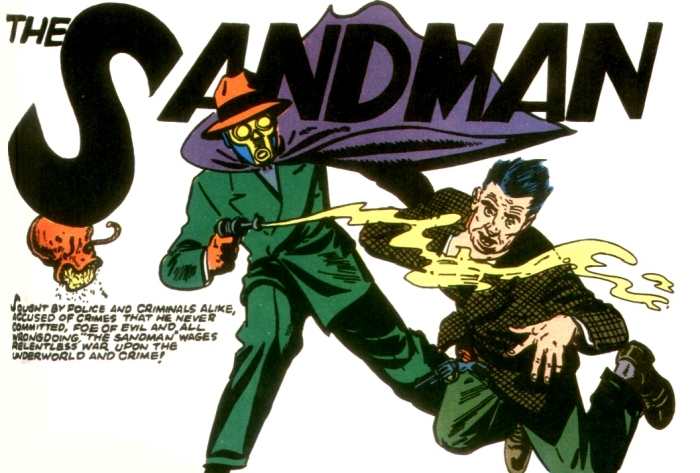 Synopsis Synopsis: An underworld tip-off lets The Sandman know that an attempt will be made on the Van Leew emeralds this evening. Although he arrived too late to prevent their theft, The Sandman nevertheless got there ahead of crook, Flip Benson - which is interesting since Benson was the man he expected to attempt the heist. Gassing the hoodlum and making a rudimentary search of his pockets, our hero comes across a pawn ticket which he pockets before departing home. "I'm supposed to be dining with Dian Belmont in half-an-hour - better hurry!"
 Conveniently managing to mix business with pleasure, Wesley Dodds exchanges words with Dian's District Attorney father when he arrives at their palatial estate. Hearing once more of the evening's robbery, Dodds learns that the D.A. suspects Mad Maddon of their theft seeing as how the criminal broke out of prison only a few days prior. Dodds' thoughts? "Looks like he did the job!"
And then it's off to dinner for Wesley and Dian... ...or perhaps not. Suggesting that Dodds instead follow his lead, The Sandman heads over to the home of Frank Fencet, the pawn broker. Breaking in as Dian waits in the car, The Sandman succeeds in cracking Fencet's safe overheard by the broker who approaches from another room - neither The Sandman and Fencet find what they expected. "I can't understand it - the jewels are not in the safe!"
Taking his leave before he is discovered, Fencet enters the room.
"Why, there ain't nobody here! Very funny! I'm sure I heard something!"
Which isn't to say that Fencet is alone. Entering Fencet's home, Flip Benson demands to know what the middleman has done with the gems Maddon was supposed to have dropped off that evening. Professing that Madoon never showed, a skeptical Benson slugs the fence. "Don't lie to me you - pig!"
The tiff is overheard by The Sandman even as he clambers down the side of Fencet's house. "Sounded to me like Fencet was telling the truth - but where ---? -That's the mystery - where are the Van Leew emeralds???"
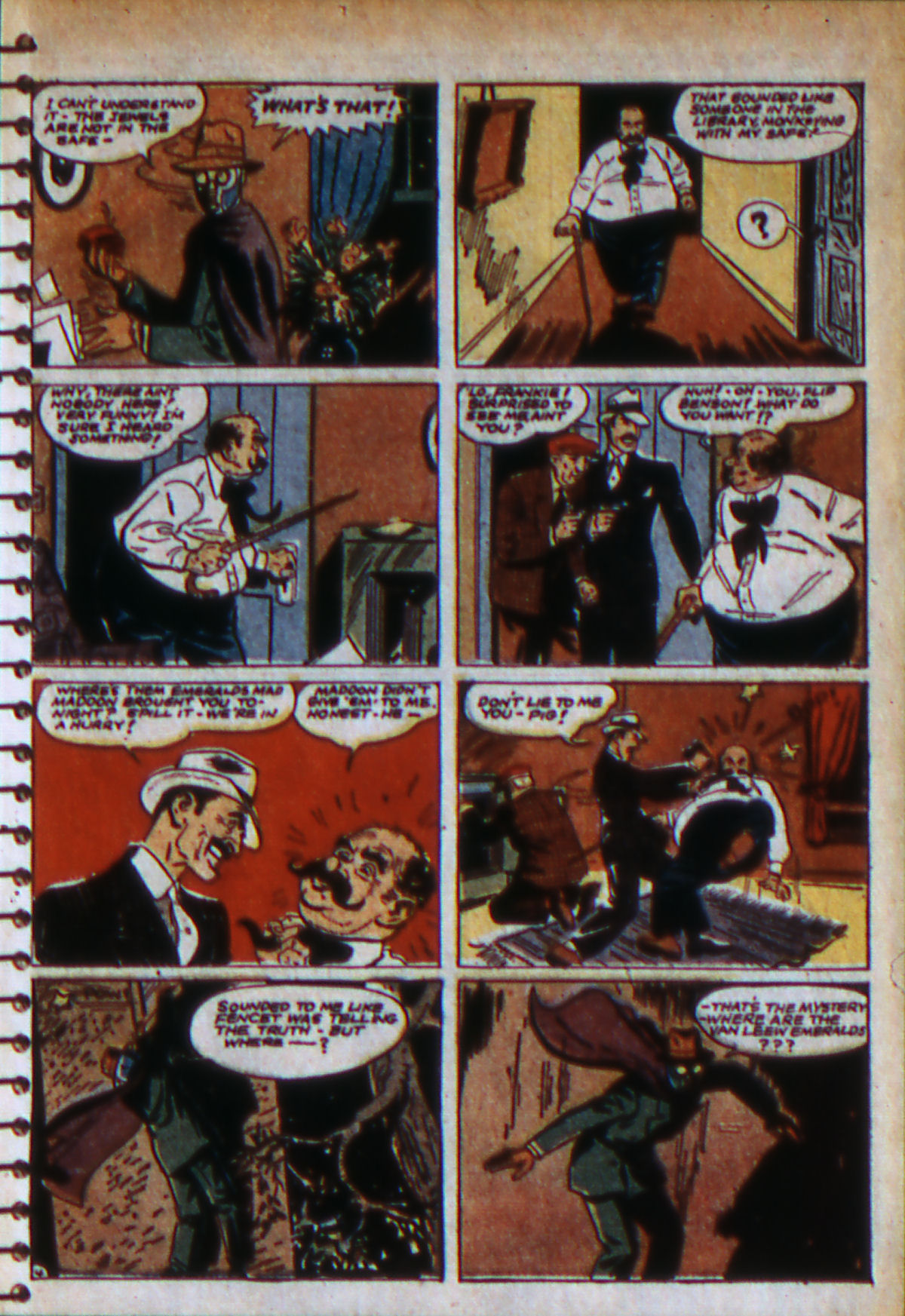 Re-entering the house through the front, The Sandman sneaks up on Benson as he extracts a confession from Fencet. What he hears, takes him completely by surprise. "All right - Madoon took them to Wesley Dodds' house!"
After regaining his wits, The Sandman announces his presence by way of a flying tackle delivered to Benson, a kick to the stomach of his partner, and a slug to the gut of Frank Fencet. With the villains subdued, the crime buster demands that Fencet finish his story. "Yeah - I'll talk, Sandman! Maddon wanted a secure place to hide the jewels, so he picked out one of them society guys' safe to put 'em in - Wesley Dodds..."
Demanding to know where "this Wesley Dodds" person resides ("Park Drive") The Sandman takes off as the crooks give chase. Filling Dian in on the details, the pair head over to The Sandman's own home where our hero explains that for Dodds own safety, The Sandman must be seen stealing the gems from his safe. After momentarily basking in the glow of the million dollar gems, The Sandman makes the necessary precautions. "I'll scatter The Sandman's calling card - sand, to tell the police and crooks that The Sandman robbed Dodds."
After that, Dodds and Dian head out for dinner to establish their alibi for the evening.  Good thing too, since when the pair arrive back at Dian's they find a group of policemen outside speaking with her father. Inquiring as to the reason behind this, the couple is informed by Dian's father himself: "Mad Maddon is dead. The Sandman killed him in your home, Wesley!"
Explaining on the car ride over that they had been tipped off to the murder an hour ago, The D.A. leads the pair into Dodds' home where, sure enough, Maddon lays dead beneath an incriminating sprinkling of sand. Dissatisfied with being so implicated in Maddon's murder, Dodds sneaks away to Benson's yacht where he interrupts their torture of Frank Fencet. "They're torturing Fencet to discover who has the emeralds!"Overpowering and gassing the men, all that's left for The Sandman to do is to return the jewels to their rightful owners and call it a night. And that's exactly how the tale ends. 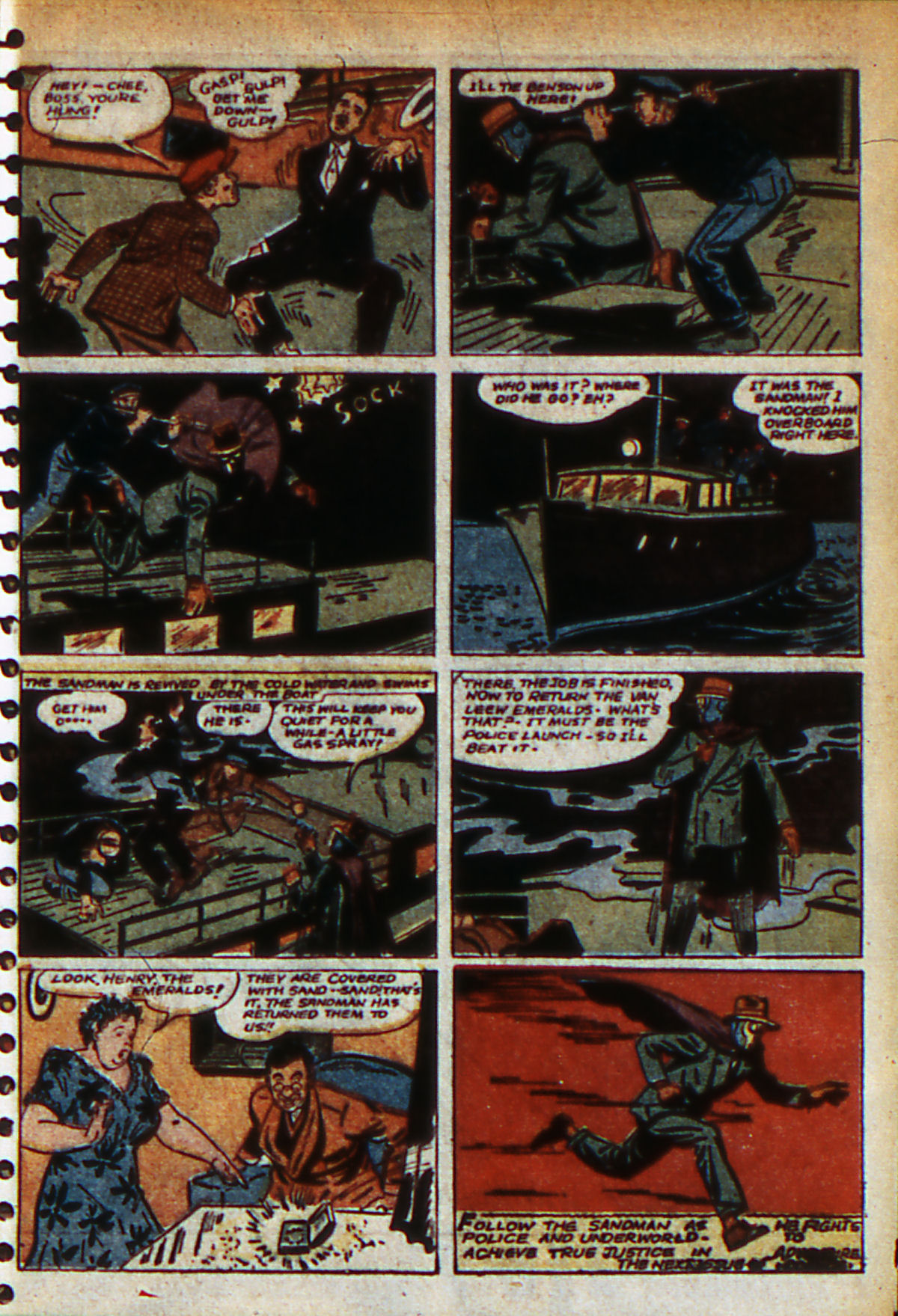 Thoughts Thoughts: While hiding the Van Leew gems in Wesley Dodds' safe strikes me as a rather questionable strategy for securing their ill-gotten ware, I'm willing to chalk this plan up to "I guess they don't call him 'Mad' Maddon for nothing" since I liked where this story went. A few years later and I can envision this story being repurposed as a more lighthearted comedy of errors, here in 1940 however, the humour is often dark. Flip Benson is a thoroughly unpleasant character - pistol whipping and later threatening Fencet with torture by shaving razor - and finds himself on the receiving end of a hangman's noose fashioned by The Sandman. Toss in a dead body in Dodds' home and things get downright grim. We've all heard that The Sandman has been accused of "crimes he never committed" but the stories have been vague on just what these offenses were. Here, however, we have at least one erroneous accusation of murder which The Sandman can't blame anybody for but himself. Sure, he never that sand intending for it to be later linked to the murder of Maddon, but deciding to change into The Sandman in his own home and then allowing himself to be seen by at least one police officer certainly places him at the scene of the crime. Why Dodds didn't simply use the pretense of escorting Dian home when her fainting spell provided this opportunity to go after Benson is beyond me. Though she still serves a purpose in these stories - whether it be driving The Sandman around, tending to his injuries, egging him on to capture crooks, or whatever - one thing we're not seeing Dian Belmont do is crack safes. The expert safecracking adopted daughter of an expert safecracking crook doesn't really seem to do any safecracking these days despite it being her stock-in-trade. Not a big deal - one can assume that The Sandman is no slouch in this department either - but it does suggest that some of the unique shadiness of the character is drifting away. I will, however, credit Fox for presenting her father, The District Attorney in a more dignified light than has become the norm. There's no sign of the apoplectic buffoon from installments past so perhaps I'm just damning with faint praise. On a final note, get an eyeful of that cover since it'll be the last one to feature The Sandman for awhile. Adventure Comics #60 is where he'll turn up next for this title at least. He'll pop up on most of the covers of All-Star Comics so there will be that consolation at least. Alright, nothing else springs to mind about this one. 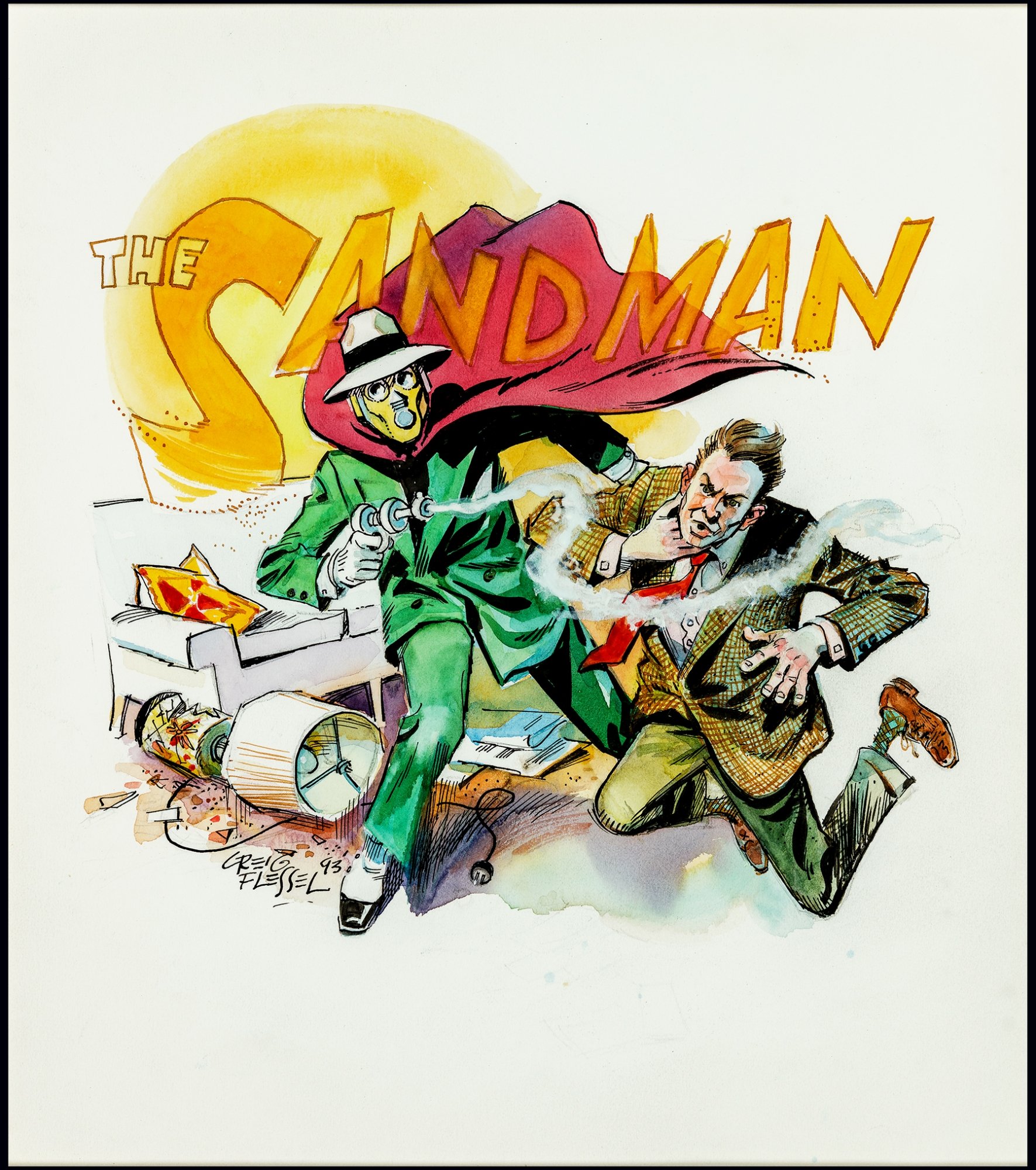 |
|
|
|
Post by MWGallaher on Jul 4, 2024 12:24:51 GMT -5
Maybe it's just me, but it felt a little harder to fill in the gaps on that plot than it ought to have. So Benson catches up with Madoon sometime while Wes and Dian are dining, and Benson, Madoon, and Fencet (ha!) go to Wes's estate to retrieve the jewels, which are now missing. Madoon is unable to explain the disappearance, so Benson kills him at the spot, inadvertently setting up the Sandman, who had left his "calling card" (although I doubt that a sandy floor would hold up as evidence in court). Assuming Fencet is in on the plot, Benson abducts Fencet to his yacht to extract Fencet's nonexistent knowledge via torture, and Wes, already knowing about Benson's yacht and having confirmed his involvement, plays his hunch that his prey is on the boat.
Leaving Benson and Fencet unbound read like a mistake (I had to backtrack to confirm that the two were indeed free to carry on after their encounter with The Sandman), but I suppose the story does adequately justify the urgency to abandon the fight and get to the safe at the Dodds residence before Madoon could return. I would think there was at least enough time for The Sandman to gas the pair before high-tailing it, but even so, it wouldn't have kept them unconscious for the whole time that Wes and Dian were dining. (I don't think it was ever stated explicitly, but I assume the gas only puts someone out for a few minutes.)
Not an exceptional story, but it does feel like they've settled on the right tone for the feature, emulating the detective pulps. It's an obvious tone to strike, sure, and I wish that when they did veer away from it, they'd have gone more in the direction of the "weird menace" stories that would crop up in co-feature Hour-Man rather than all the flying and diving they did.
|
|